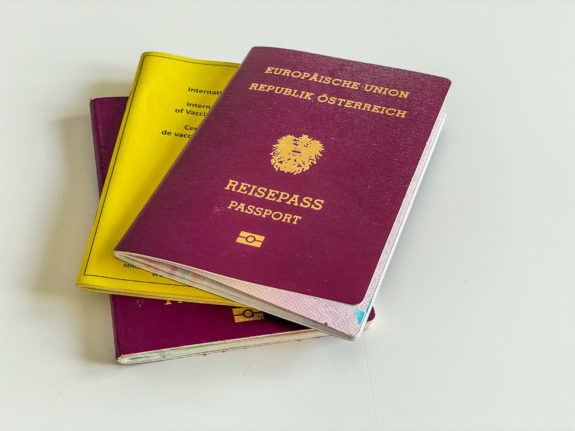If you do not have Austrian citizenship or residency permissions but want to live and work in Austria, you’ll generally fall into one of two categories.
For citizens of EU/EFTA countries, you will be able to live and work in Austria relatively easily due to the EU’s freedom of movement rules.
For people who are not a citizen of an EU country – known as ‘third country citizens’ – this can be a little more difficult.
Here’s what you need to know.
How can I come to Austria?
As a non-EU citizen, this can be relatively difficult.
Austria’s rules regarding residency and citizenship tend to be relatively restrictive, however getting a work permit is not incredibly difficult – particularly if you already have work in Austria.
READ MORE: Why do so few foreigners become Austrian?
It will however require a fair amount of paperwork – something you’ll need to get used to after moving to Austria.
Keep in mind the differences between residency permits and simply getting onto Austrian soil.
In normal – i.e. non-coronavirus – times, people from most ‘third countries’ can visit Austria for up to 90 days without a visa, but when it comes to becoming a resident in the country and working, things get a little more complicated.
If you plan to stay in Austria for more than six months then you will also need a residence permit to enter the country. You can get this from an Austrian embassy or consulate before you move to Austria.
How do you get a residency permit in Austria?
Fortunately, skilled workers are in demand in Austria.
In order to move to Austria to work, you’ll need to get one of three types of residency permits.
The three types of work permit in Austria are: restricted (for one year), standard (two years) and unrestricted (for five years). What you can get will depend on your situation.
The Red-White-Red Card
The Red-White-Red Card is a permit for qualified workers and their families to live and work in Austria.
To qualify, applicants need to have enough points based on education, professional experience, age and language skills.
The points system for the Red-White-Red Card is split into several categories, as detailed below.
Very Highly Qualified Workers – if you score 70 points you can get a six-month Job Seeker Visa to enter Austria and find work. If you receive a job offer you can then apply for the Red-White-Red Card.
Skilled Workers in Shortage Occupations – if you score 55 points and have a job offer you can apply for a 24-month permit. Professions include engineers, carpenters and nurses.
Start-Up Founder – to be eligible for this category you need 50 points and €50,000 in funds. There are bonus points for being under 35 and having an additional €50,000 to invest.
Graduates – if you graduate from an Austrian university, you can extend a student residence permit for 12 months to find a job or start a business. To stay on a long-term basis, graduates need to earn a minimum of €2,500 per month.
Self-employed key workers – this category is outside of the points system. Instead, you need to invest €100,000 into the Austrian economy and create jobs or introduce new technologies.
Other key workers – to qualify for this category you need 55 points and a minimum salary of €2,775 per month for people under 30, or €3,330 for people over 30.
The EU Blue Card
The EU Blue Card is similar to the Red-White-Red Card, except it doesn’t involve a points system to qualify.
To be eligible, you need to be educated at university level, have received a job offer in Austria, will earn one and a half times the average salary and have passed the labour market test (proof that there is no one local that can do the job).
READ MORE: Just how good does your German have to be to gain residency and citizenship?
Additionally, the EU Blue Card gives holders free movement within the EU and permanent residency rights.

What other options are there?
Studying is another way to move to Austria.
Many Brits take this route in countries like Australia and New Zealand after a working holiday visa has expired. The benefit of studying is gaining new skills and the possibility of being able to stay long-term with a job offer after the course has finished.
READ MORE: What you need to know about applying for Austrian citizenship
Austria has an excellent education system and there are even many degree programmes taught in English.
You now need to apply for a residence permit for study purposes (Aufenthaltsbewilligung – Student) and pay international tuition fees.
Then there is a settlement permit for retirees. This involves showing proof of sufficient funds, health insurance, a place to live and some understanding of the German language.
In a nutshell, moving to Austria can be difficult.
But it’s not impossible – as long as you have the right skills, you want to study or you have the right amount of money.
What about the United Kingdom?
Unfortunately for people from the United Kingdom, Brexit does in fact mean Brexit and things got a little harder recently.
As of January 1st, 2021, the United Kingdom is no longer a member of the European Union and is therefore considered a ‘third country’ for the purposes of Austrian immigration.
If you’re a citizen of the United Kingdom, we’ve outlined the steps you can take to live and work in Austria in the following guide.
READ MORE: How Britons can move to Austria to live and work post-Brexit
That said, the information in this guide will also apply to you.



 Please whitelist us to continue reading.
Please whitelist us to continue reading.
Member comments